
If we told you that 50% of all meetings are a waste of time, would you believe us? In fact, each employee spends about 31 hours in unproductive meetings over the course of one month.
And here's something else interesting:
- 91% of employees daydream during meetings
- 73% do other work
- 39% sleep
- 45% complain about the number of meetings they attend
The sad news is that unproductive meetings are also expensive, costing US businesses $37 billion every year.
This is where it gets worse: remote working is increasing the amount of time employees spend in meetings. A report from Reclaim.ai shows that employees now spend 25.3% more time in meetings compared to pre-pandemic times.
But meetings shouldn’t be where productivity goes to die. Meetings should be the place where real work gets done.
So, is there a way to make meetings productive again?
The answer is yes! Everyone can learn how to host productive meetings, whether their team is in-office, remote, or hybrid. The key is to plan and write an effective meeting agenda.
In this post, we'll look at several tips and best practices for how to write a meeting agenda. Stay tuned until the end, where we provide you with team meeting agenda templates for the most common types of meetings.
Let's dive in!
What Is a Team Meeting Agenda?
A team meeting agenda is a document that contains the specific details of a meeting. The purpose of the agenda is to inform attendees what to expect during a meeting and how they can prepare for it. Additionally, meeting agendas help you use your time wisely by organizing the meeting into separate topics and allocating a specific amount of time for each topic. This way, you'll prevent the meeting from getting off track and you'll get to discuss the most critical points.
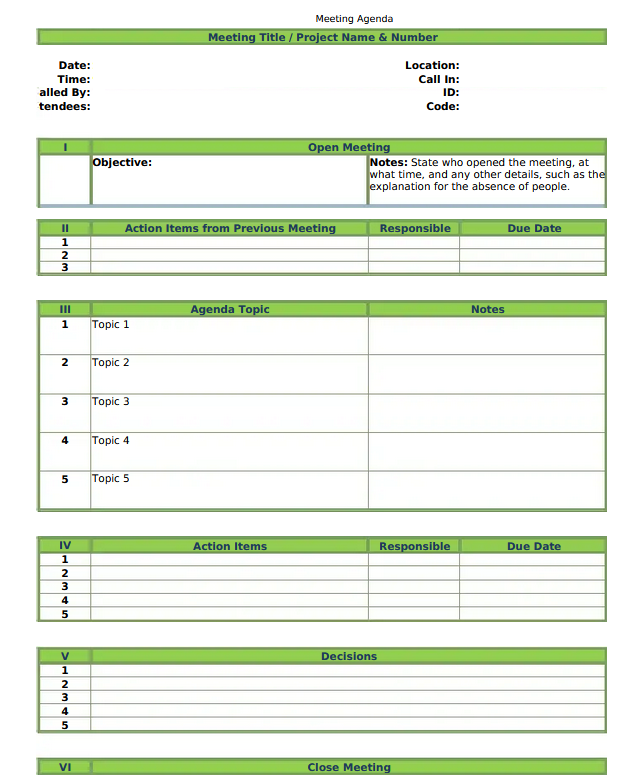
Why Create a Team Meeting Agenda?
How many times have you attended a meeting that veered off-track? Or a meeting that dragged on for hours? It happens to the best of teams! And that's why you need a team meeting agenda in place. In short, team meeting agendas inform participants of what the meeting is about and let them prepare beforehand.
In addition, making an agenda for a meeting ensures that all topics are discussed promptly. It keeps the participants focused on the topic at hand. The best thing is that effective meeting agendas deliver a tangible result: a decision, a plan, a list of ideas, or a shared understanding of the work ahead.
Without exaggerating, we can safely say that team meeting agendas can transform unproductive meetings into meetings where amazing things happen!
How to Write an Effective Team Agenda
Planning and writing agendas for meetings can be a complicated undertaking. It can be hard to know where to start with all the different elements that go into one. This chapter will take you through the process of how to write a meeting agenda that is clear, concise, and easy to follow.
Let’s take a closer look!
1. Establish the Meeting's Objective
Think about this for a moment: what is the purpose of the meeting you're organizing? Is it to share information? To brainstorm ideas? To come up with a solution to a problem? Creating an objective makes it clear why a meeting is being held and what the meeting is seeking to accomplish.
You need to know this information and share it with others before anything else. Knowing the objective gives participants insight into what the discussion will be centered around.
Once you have established the objective of the meeting, it will be easier for you to come up with all the items that should go on the business agenda.
For example, the meeting's objective can be:
“Brainstorm 10 ways we could improve organic traffic by the end of the year.”
If you can't think of an objective for the meeting, this is a sign the meeting is a waste of time and should be handled via a tool like Slack.
2. Use Verbs to Inspire Action
Each item on the agenda should begin with an action word (verb) to clarify to attendees what the meeting is aiming to accomplish.
For example, don't say, "Growth opportunities," but "Discuss growth opportunities." Verbs can inspire people to get motivated and take action.
Let's say you're meeting with the marketing team on a weekly basis. Your department meeting agenda can look something like this:
- Share past week's wins.
- Review weekly KPI goals and compare them with actual numbers.
- Review to-do list.
- Identify issues.
- Discuss ways to fix issues.
- Recap next week's to-do list.
3. List and Organize Agenda Items
Here's a fact:
Just because a meeting has an agenda in place doesn't mean attendees will automatically have a great meeting experience.
What matters is not the agenda but the relevance and importance of what's on the agenda, i.e., the agenda items. They are the critical ingredient that can lend a nice flow to the meeting. For example, a good meeting structure is to have all informational items go before the discussion items so your team has all of the information before diving into a discussion.
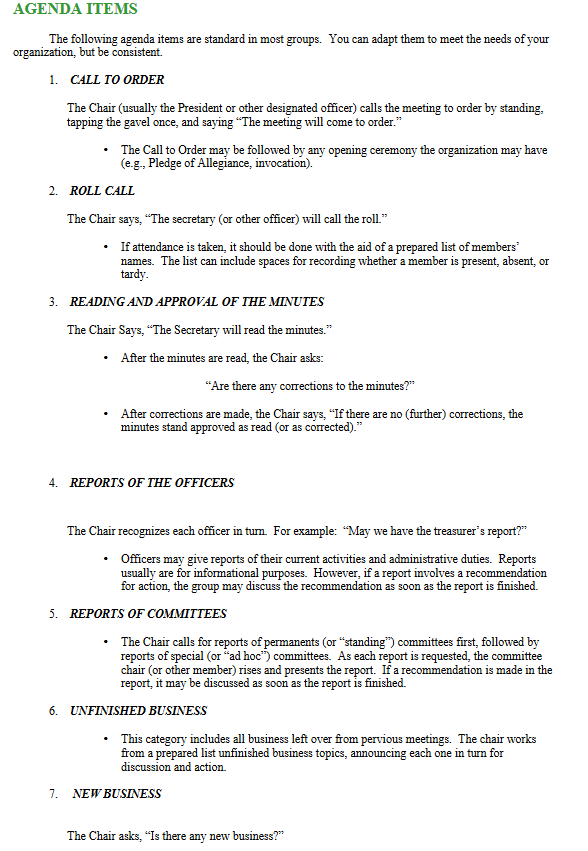
Let's take a look at some of the best practices when it comes to listing and organizing agenda items to include in your meeting:
Be Specific
Take a moment to think: what items need to be covered during the meeting? Be as specific as possible and give each topic a time slot. Being specific with the agenda items makes sure participants understand the problem/challenge. On the plus side, breaking your agenda into sections makes it easier for everyone to follow along—and it ensures the meeting doesn't drag on for too long.
Organize Agenda Items by Priority
The science of meetings has discovered something interesting:
Items with early agenda positions receive more time and attention.
This brings us to the next tip for how to write a meeting agenda: discuss your most pressing questions at the start of the meeting. You will ensure key issues are covered, even if you run out of time. For example, you can start with a 5-minute intro to the meeting and jump right into discussing the most challenging and important topics.
Bonus tip: Instead of listing agenda items as bullet points, consider transforming them into questions. For example, rather than simply writing "Remote Work," you could write, “Under what conditions should we consider remote work?” "Budget Problems” can be reframed as “How can we reduce our spending by 50K by the end of the fiscal year”? Using questions will make you think more critically about the meaning of a topic and what your goal is. It will also help you determine your invitation list (the people who can answer the questions are essential).
Estimate and List Time for Each Topic
When meetings last longer than planned, participants tend to get frustrated and lose focus. And this is totally understandable. Some of them might have other meetings scheduled or urgent tasks that need their attention.
That's why you want to keep meetings within the estimated time frame. And the best way to ensure your meetings don't drag on for too long is to estimate and list the time for each agenda item. The person leading the meeting or a particular topic will know how much time they have at their disposal so they can adapt their talking points.
Bonus tip: Avoid packing your meeting agenda with too many items. If you want the meeting to be meaningful and not overly rushed, list a few pressing items and determine the time it would take to go through them all. For instance, estimate how much time it would take to introduce a topic, discuss the topic, answer questions, generate solutions, and agree on future action items.
4. Define a Process for Addressing Each Agenda Item
Good meeting leaders consider what items need to go on the agenda. The best meeting leaders define a standardized process for addressing each agenda item.
Agreeing on a process is critical as it can increase meeting effectiveness. Without a clearly defined process in place, the meeting can quickly become chaotic and unfocused. Some attendees will focus on identifying the potential cause of the problem, others will brainstorm ideas, and some will wonder why they're attending the meeting in the first place.
So, once you create a process for addressing each agenda item, include it on the written agenda. Explain the process and seek agreement. Some attendees might have suggestions for refining the process.
Let's say you're organizing a meeting to address the recent dip in organic traffic. The process can look something like this:
- Define the problem (5 minutes)
- Brainstorm every potential cause for the problem (10 minutes)
- Brainstorm possible solutions (15 minutes)
- Discuss, debate, and agree on the course of action (15 minutes)
5. List Participants
News flash:
The most effective meetings have the right people at the table.
Holding meetings with a smaller group of people leads to faster decisions and more engaged employees. Invite too many attendees and the meeting can quickly become unfocused and a waste of time. There's even a concept called "social loafing," which stipulates that people are prone to exert less effort when working collectively as part of a group.
Inviting too many people can waste attendees' time, too. Instead of attending the meeting as mere spectators, these people would be better off focusing on other tasks that need their attention.
Not to forget that meetings are costing you money. Let's say you have a one-hour meeting with four attendees at $70 an hour. This meeting is costing your company $280. You may want to check out this Meeting Cost Calculator by the Harvard Business Review and see how much you’re spending on meetings.
Here's the point: to avoid this trap, make sure you identify the meeting's objective, along with the specific agenda items to determine which employees should attend. Who can contribute meaningfully? Who should hear what is being discussed in the meeting, and there's no other way for them to get this information?
As we mentioned earlier, using questions instead of simple phrases for the professional agenda items will help you determine your invitation list. Why? Because the people who can answer these questions are the essential participants.
6. Determine Roles and Assign Responsibility
The final tip for how to write a meeting agenda is to determine the roles for participants and assign responsibility. Make sure you identify who is responsible for leading each topic so they can prepare beforehand.
If someone needs to record the remote meeting, let them know. If someone is expected to prepare a presentation, convey this information to them. Don't let them come to the meeting unprepared as this can negatively affect their engagement.
Meeting Agenda Best Practices
Now that you have successfully created a meeting agenda, it's time to think about how you will share it with people and refine it. You might think your agenda is flawless, but there's always something you can do to improve it.
Here are three tips to bear in mind:
1. Distribute Agenda Ahead of Time
Share the meeting agenda with attendees as soon as possible. This is where an Internal knowledge base software for teams can come in handy. By storing your meeting agenda in your knowledge base, you can make the agenda easily accessible to all meeting participants.
Another step to consider is including the agenda on the meeting invitation so that it's visible to all attendees and is easily located. This also leaves room for participants to suggest modifications.
As a general rule of thumb, meeting agendas that contain strategic questions should be sent to attendees at least one week before the meeting date. For most other questions, a three-day lead time should suffice.
2. Actively Seek Input
When organizing a meeting, your first task is to write the agenda items. Once you do this, share the agenda with all attendees and seek their input.
There are several benefits to this. The first benefit is that seeking input ensures you select topics that affect the entire team. Secondly, meetings are a collective experience, so it is essential to allow all participants to share their thoughts and ideas. What's more, asking for attendees' input is excellent for employee empowerment. You're letting people know their thoughts and ideas matter to you, which can be vital for employee engagement.
If you decide not to include an item an attendee suggested, explain your reasoning.
3. Leave Time at the End for Review
Finally, don't forget to leave time for review at the end of the meeting. Discuss the design of the agenda. Was it easy to read? Did you make use of proper headings, subheadings, bullet points, etc.? What do participants think?
Let all attendees review the meeting and the meeting agenda with questions like:
- Did the right people attend the meeting? If not, who should be added to the invite list?
- Was the meeting's objective clear?
- Did we include the right agenda topics?
- Was the agenda sent in time for everyone to prepare?
- How well did we estimate the time needed for each agenda item?
- How effective was the process for addressing each agenda item?
- Was it easy for you to contribute to the discussion?
- Are we holding this meeting at the right time?
Getting feedback from people will help you hold even more effective meetings in the future. On the plus side, getting feedback can empower those who are less outspoken to share their thoughts.
Team Meeting Agenda Examples and Templates
So far, we've covered the pros of creating a meeting agenda and discussed some tips for how to write a meeting agenda. The fact that you arrived at this point of the post shows just how committed you are to running a great meeting. Kudos to you!
We've created the following chapter to inspire you to get started on your next staff meeting agenda. The good news is that these team meeting agenda templates can ensure your team remains organized and efficient. You can easily adapt each of these templates to create an agenda that fits your team.
So let's fire away and look at 12 different meeting agenda templates:
Staff Meeting Agenda Template
This staff meeting agenda is perfect for informal meetings as well as impromptu meetings. With this agenda template, you'll be able to ensure that your meeting stays on track. Additionally, your staff meeting will be more effective as this template will help attendees understand how to best prepare for the meeting.
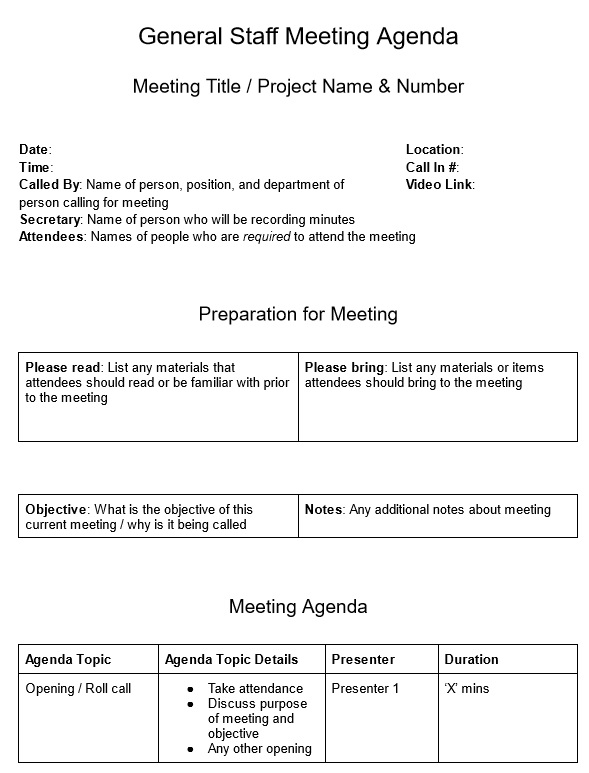
Word | PDF | Google Docs
Leadership Meeting
Leadership team meetings include leaders across the organization who come together to discuss issues, make decisions, and stay aligned. For example, leaders can discuss issues like key metrics, operations, and current processes. Having a meeting agenda in place can help the leadership team arrive at better business decisions.
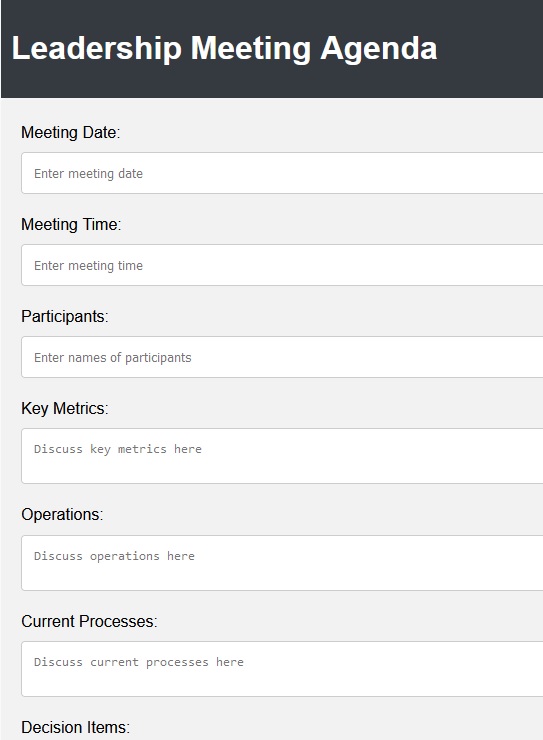
Weekly Team Meeting
A weekly team meeting is a meeting that takes place at the same time every week and includes the entire team. These meetings are an opportunity for teams to get together and discuss new developments from the past week, analyze issues, and share updates. Using a weekly team meeting template will help keep you on track and ensure you and the team have a productive meeting.
All-hands Team Meeting
An all-hands team meeting is a company-wide meeting that includes every employee and is usually organized by the CEO. The objective of the meeting is to discuss the company's goals, share achievements and positive results, have employees ask questions, present new features, etc. Considering these types of meetings involve many people, it's critical that you use a meeting template. A meeting template can help foster a culture of collaboration and open communication.
One-on-one Meeting
A one-on-one meeting is a meeting between an employee and their manager that usually happens on a quarterly basis. The meeting is an opportunity to discuss the employee's professional development, any challenges the employee is facing, provide feedback, and more. Meeting agenda templates inform the employee what will be discussed during the meeting so they can prepare well, and they ensure the discussion doesn't go off-topic.
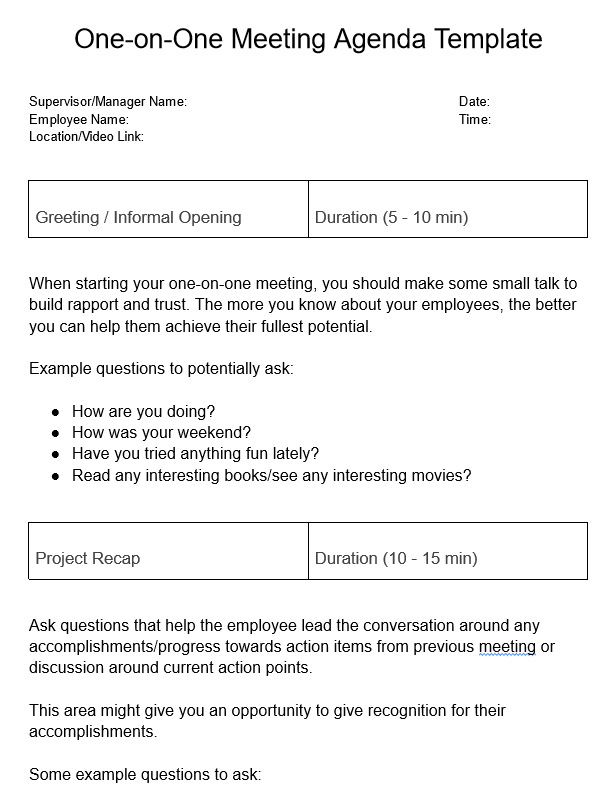
Word | PDF | Google Docs
Brainstorming Team Meeting
Brainstorming team meetings are great for coming up with ideas and solutions to a problem. For example, you and the team might need to come up with a new advertising campaign and need to generate creative ideas. During such meetings, there's always the risk of the more outspoken attendees hijacking the conversation. Creating an agenda for a meeting of this kind can help with these issues by empowering every participant to speak up. At the same time, it can give structure to the conversation.
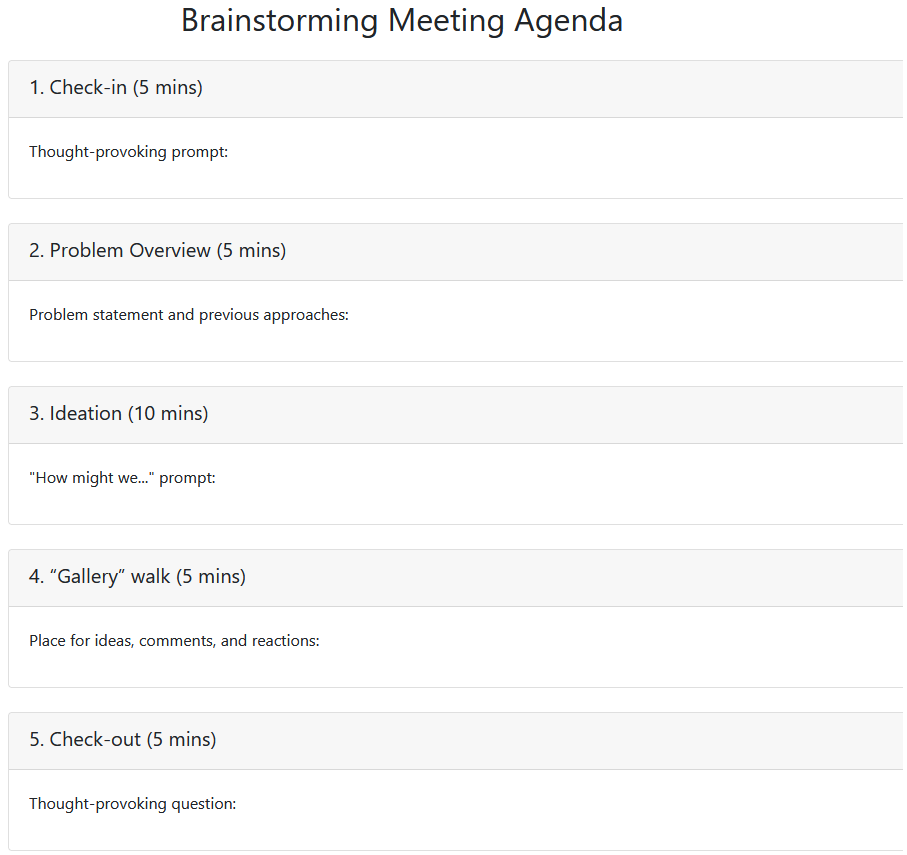
Project Kickoff Meeting
Project kickoff meetings take place before the start of a new project. It's the first time the team meets to discuss what will happen when working on the project, how work will be done, and how success will be measured. After the meeting, everyone should be on the same page.
Project Check-In Meeting
Project check-in meetings aim to discuss how the project is progressing and talk about project wins, challenges, and setbacks. A company meeting agenda can include items like "Project recap" or "Unexpected roadblocks." Ultimately, this will help you have a productive conversation.
Sprint Review Meeting
A sprint review meeting is an important part of the Agile methodology. The review meeting happens at the end of every iteration, which is usually two weeks long. It's a chance for everyone on the team, including developers, project managers, designers, and stakeholders, to assess what they've achieved and how it fits with the overall project goals.
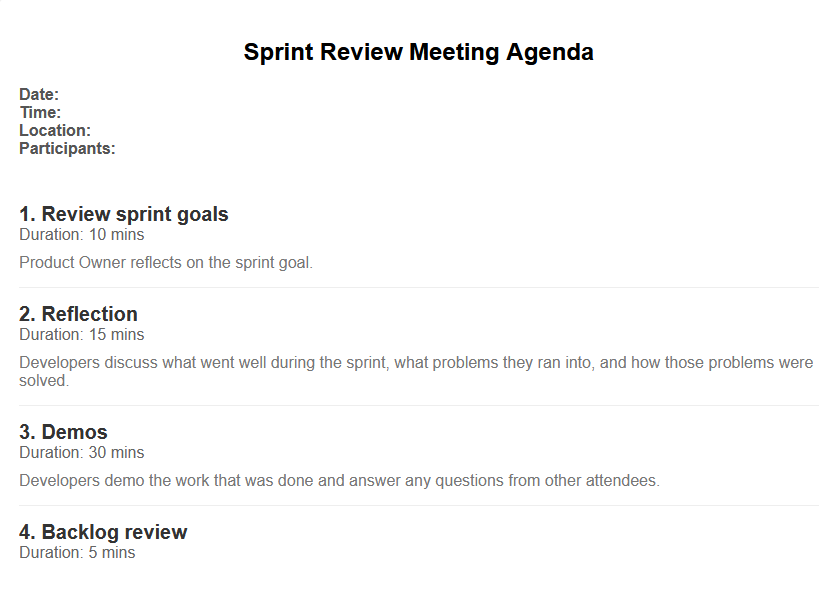
Daily Standup Meeting
A daily standup meeting is a quick meeting held to check on progress for group tasks. It's also known as the 10-minute meeting. The time limit is deliberate because it forces people to stay focused on what they've done the day before and what they plan to do today. The point of the standup meeting is to encourage communication among team members, prevent duplication of work, and manage expectations.
Quarterly Strategic Meeting
The goal of quarterly strategic meetings is to review the company's strategic progress and establish targets for the next 90 days. A quarterly planning template can help keep these meetings on track and focused on the issues at hand.
Retrospective Meeting Agenda
A retrospective meeting is held to discuss a completed sprint. The team comes together to discuss what went well during the sprint, identify pitfalls, and propose new ideas to improve future projects.
Wrapping Up
The ultimate goal of you as a meeting leader is to make sure you host effective meetings that leave everyone feeling inspired rather than frustrated. To achieve this, you need to create an effective meeting agenda.
An effective meeting agenda clearly states the meeting's objective and breaks the meeting into separate sections to make it easier for everyone to follow along. Another tactic for creating an effective meeting agenda is to organize the agenda topics by priority and estimate the time for each agenda item.
Holding meetings with a smaller group leads to faster decisions and more engaged employees, so make sure you invite only the essential participants. And don't forget to indicate who will lead each topic so people can prepare.
Finally, discuss the agenda with your fellow attendees, and ask for feedback with questions like, "How well did we estimate the time needed for each agenda item?" This feedback will help you plan even better for your next meeting.
Now that you learned all the best practices for how to write a meeting agenda and are armed with meeting agenda templates, it's time to start crafting your own! Good luck!
FAQs
How do you write a meeting agenda?
- Establish the meeting's objective
- Use verbs
- List and organize topics to cover
- Define a process for addressing each agenda item
- List participants
- Determine the roles for participants and assign responsibility
What is the format of an agenda?
Each agenda should be organized by agenda topics. This makes it easier for participants to follow along and prevents the meeting from veering off-track. Each item on the agenda should begin with an action word (verb) to clarify to attendees what the meeting is aiming to accomplish. Another strategy is to list agenda items as questions to encourage attendees to think more critically about the meaning of a topic.
What are agenda items?
Agenda items are the distinct parts of a meeting agenda that should be discussed during a meeting. Organizing the meeting agenda into separate agenda items makes it easier for participants to follow along and prevents the meeting from veering off-track. Generally, the meeting organizer writes the agenda items, although they can also request attendees to suggest agenda items.
How do you end an agenda for a meeting?
The best way to end an agenda for a meeting is to leave time at the end of the meeting for a review. Getting feedback from people will help you hold even more effective meetings in the future. On the plus side, getting feedback can empower those who are less outspoke to share their thoughts.
What is a good agenda for a team meeting?
A good agenda for a team meeting clearly states the meeting's objective. It organizes the meeting in separate agenda topics and estimates the time for each agenda item. The best meeting agendas organize the topics in order of importance, by priority, to ensure key issues are covered.


